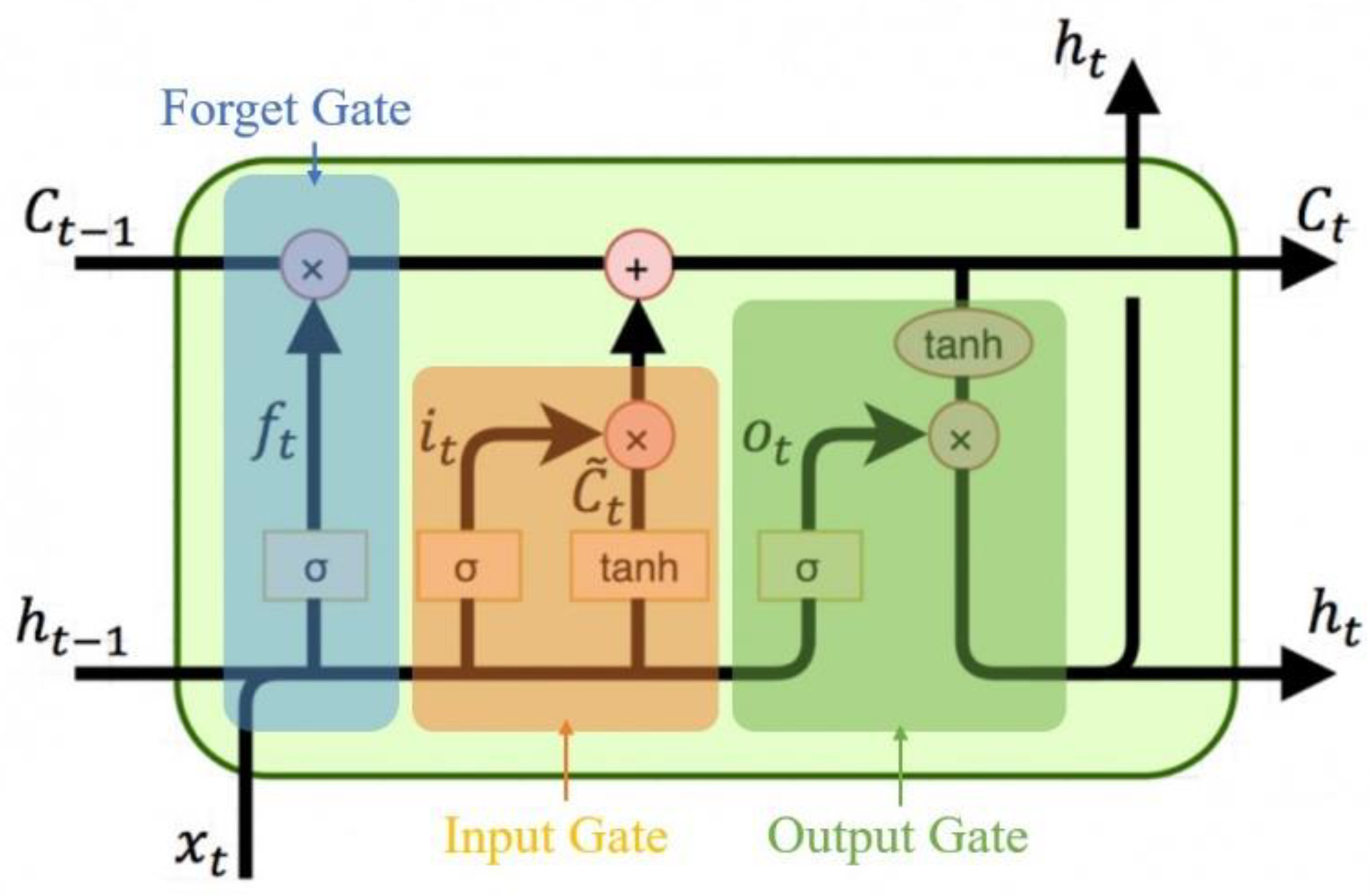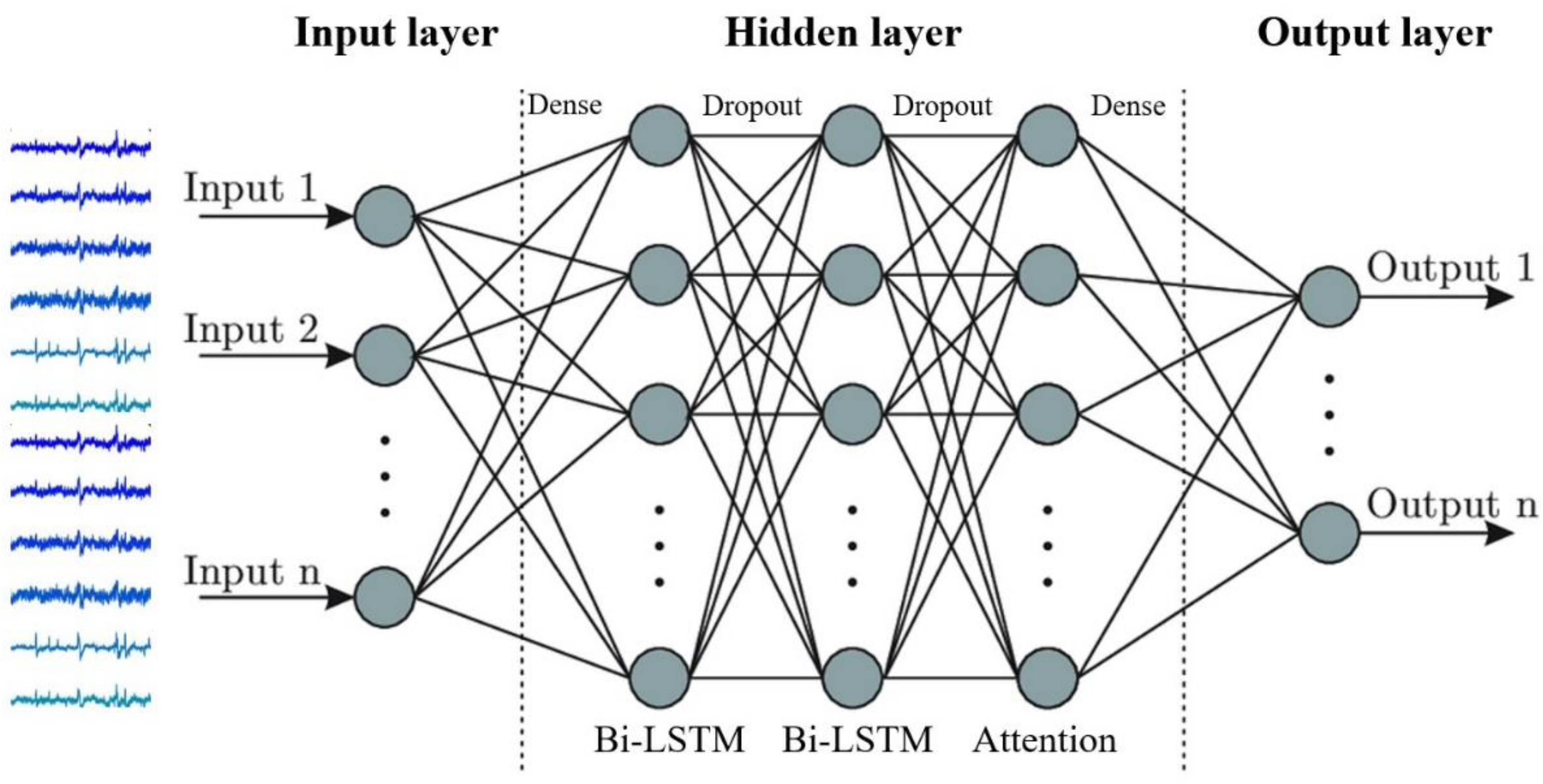Prediction of Cognitive Load from Electroencephalography Signals Using Long Short-Term Memory Network
Abstract
1. Introduction
2. Related Work
2.1. Cognitive Load
2.2. Preprocessing and Feature Extraction
2.3. LSTM-Based Recurrent Neural Network
2.4. Bi-LSTM
3. Materials and Methods
Deep Learning-Based Cognitive Load Analysis Model
4. Results
5. Discussion
Author Contributions
Funding
Institutional Review Board Statement
Informed Consent Statement
Data Availability Statement
Conflicts of Interest
References
- Salta, K.; Paschalidou, K.; Tsetseri, M.; Koulougliotis, D. Shift from a traditional to a distance learning environment during the COVID-19 pandemic: University students’ engagement and interactions. Sci. Educ. 2022, 31, 93–122. [Google Scholar] [CrossRef] [PubMed]
- Singh, J.; Singh, L.; Matthees, B. Establishing social, cognitive, and teaching presence in online learning—A panacea in COVID-19 pandemic, post vaccine and post pandemic times. J. Educ. Technol. Syst. 2022, 51, 28–45. [Google Scholar] [CrossRef]
- O’Keefe, R.; Auffermann, K. Exploring the effect of COVID-19 on graduate nursing education. Acad. Med. 2022, 97, S61. [Google Scholar] [CrossRef] [PubMed]
- Cui, Y.; Ma, Z.; Wang, L.; Yang, A.; Liu, Q.; Kong, S.; Wang, H. A survey on big data-enabled innovative online education systems during the COVID-19 pandemic. J. Innov. Knowl. 2023, 8, 100295. [Google Scholar] [CrossRef]
- Likourezos, V.; Kalyuga, S.; Sweller, J. The variability effect: When instructional variability is advantageous. Educ. Psychol. Rev. 2019, 31, 479–497. [Google Scholar] [CrossRef]
- Liu, J.C.; Li, K.A.; Yeh, S.L.; Chien, S.Y. Assessing perceptual load and cognitive load by fixation-related information of eye movements. Sensors 2022, 22, 1187. [Google Scholar] [CrossRef]
- Agbangla, N.F.; Audiffren, M.; Pylouster, J.; Albinet, C.T. Load-dependent prefrontal cortex activation assessed by continuous-wave near-infrared spectroscopy during two executive tasks with three cognitive loads in young adults. Brain Sci. 2022, 12, 1462. [Google Scholar] [CrossRef]
- Longo, L. Modeling cognitive load as a self-supervised brain rate with electroencephalography and deep learning. Brain Sci. 2022, 12, 1416. [Google Scholar] [CrossRef]
- Liu, H.; Shi, R.; Liao, R.; Liu, Y.; Che, J.; Bai, Z.; Cheng, N.; Ma, H. Machine learning based on event-related EEG of sustained attention differentiates adults with chronic high-altitude exposure from healthy controls. Brain Sci. 2022, 12, 1677. [Google Scholar] [CrossRef]
- Nafea, M.S.; Ismail, Z.H. Supervised machine learning and deep learning techniques for epileptic seizure recognition using EEG signals—A systematic literature review. Bioengineering. 2022, 9, 781. [Google Scholar] [CrossRef]
- Friedman, N.; Fekete, T.; Gal, K.; Shriki, O. EEG-based prediction of cognitive load in intelligence tests. Front. Hum. Neurosci. 2019, 13, 191. [Google Scholar] [CrossRef]
- Rubio, S.; Díaz, E.; Martín, J.; Puente, J.M. Evaluation of subjective mental workload: A comparison of SWAT, NASA-TLX, and workload profile methods. Appl. Psychol. 2004, 53, 61–86. [Google Scholar] [CrossRef]
- Hogervorst, M.A.; Brouwer, A.M.; Van Erp, J.B. Combining and comparing EEG, peripheral physiology and eye-related measures for the assessment of mental workload. Front. Neurosci. 2014, 8, 322. [Google Scholar] [CrossRef] [PubMed]
- Sweller, J.; Ayres, P.; Kalyuga, S. Acquiring information: The borrowing and reorganising principle and the randomness as genesis principle. In Cognitive Load Theory. Explorations in the Learning Sciences, Instructional Systems and Performance Technologies; Springer: New York, NY, USA, 2011; Volume 1. [Google Scholar] [CrossRef]
- Paas, F.; Renkl, A.; Sweller, J. Cognitive load theory and instructional design: Recent developments. Educ. Psychol. 2003, 38, 1–4. [Google Scholar] [CrossRef]
- Paas, F.; Renkl, A.; Sweller, J. Cognitive Load Theory: A Special Issue of Educational Psychologist; Routledge: New York, NY, USA, 2016. [Google Scholar]
- Ericsson, K.A.; Hoffman, R.R.; Kozbelt, A.; Williams, A.M. (Eds.) The Cambridge Handbook of Expertise and Expert Performance; Cambridge University Press: Cambridge, UK, 2018; pp. 793–811. [Google Scholar]
- Brünken, R.; Plass, J.L.; Leutner, D. Direct measurement of cognitive load in multimedia learning. Educ. Psychol. 2003, 38, 53–61. [Google Scholar] [CrossRef]
- Schultheis, H.; Jameson, A. Assessing cognitive load in adaptive hypermedia systems: Physiological and behavioral methods. In Adaptive Hypermedia and Adaptive Web-Based Systems; De Bra, P.M.E., Nejdl, W., Eds.; Springer: Berlin/Heidelberg, Germany, 2004; Volume 3137, pp. 225–234. [Google Scholar] [CrossRef]
- DeLeeuw, K.E.; Mayer, R.E. A comparison of three measures of cognitive load: Evidence for separable measures of intrinsic, extraneous, and germane load. J. Educ. Psychol. 2008, 100, 223–234. [Google Scholar] [CrossRef]
- Nilsson, E.J.; Aust, M.L.; Engström, J.; Svanberg, B.; Lindén, P. Effects of cognitive load on response time in an unexpected lead vehicle braking scenario and the detection response task (DRT). Transp. Res. F. 2018, 59, 463–474. [Google Scholar] [CrossRef]
- Krejtz, K.; Duchowski, A.T.; Niedzielska, A.; Biele, C.; Krejtz, I. Eye tracking cognitive load using pupil diameter and microsaccades with fixed gaze. PLoS ONE 2018, 13, e0203629. [Google Scholar] [CrossRef]
- Kumar, N.; Kumar, J. Measurement of cognitive load in HCI systems using EEG power spectrum: An experimental study. Procedia Comput. Sci. 2016, 84, 70–78. [Google Scholar] [CrossRef]
- Ikehara, C.S.; Crosby, M.E. Assessing cognitive load with physiological sensors. In Proceedings of the 38th Annual Hawaii International Conference on System Sciences, Big Island, HI, USA, 3–6 January 2005. [Google Scholar]
- Liang, Y.; Liang, W.; Qu, J.; Yang, J. Experimental study on EEG with different cognitive load. In Proceedings of the IEEE International Conference on Systems, Man, and Cybernetics, Miyazaki, Japan, 7–10 October 2018; Volume 2018. [Google Scholar]
- Confused Student EEG Brainwave Data. Available online: https://www.kaggle.com/datasets/wanghaohan/confused-eeg (accessed on 23 January 2023).
- Algarni, M.; Saeed, F.; Al-Hadhrami, T.; Ghabban, F.; Al-Sarem, M. Deep learning-based approach for emotion recognition using electroencephalography (EEG) signals using bi-directional long short-term memory (Bi-LSTM). Sensors 2022, 22, 2976. [Google Scholar] [CrossRef]
- Butt, A.M.; Alsaffar, H.; Alshareef, M.; Qureshi, K.K. AI prediction of brain signals for human gait using BCI device and FBG based sensorial platform for plantar pressure measurements. Sensors 2022, 22, 3085. [Google Scholar] [CrossRef] [PubMed]
- Ahmed, A.A.; Ali, W.; Abdullah, T.A.A.; Malebary, S.J. Classifying cardiac arrhythmia from ECG signal using 1D CNN deep learning model. Mathematics 2023, 11, 562. [Google Scholar] [CrossRef]
- Choudhary, A.; Ahlawat, S.; Urooj, S.; Pathak, N.; Lay-Ekuakille, A.; Sharma, N. A deep learning-based framework for retinal disease classification. Healthcare 2023, 11, 212. [Google Scholar] [CrossRef] [PubMed]





| Feature | Count | Max | Min | |
|---|---|---|---|---|
| 0 | Attention | 11,388 | 100.0 | 1.0 |
| 1 | Mediation | 11,388 | 100.0 | 1.0 |
| 2 | Raw | 11,388 | 1440.0 | −2048.0 |
| 3 | Delta | 11,388 | 3,964,663.0 | 448.0 |
| 4 | Theth | 11,388 | 2,567,643.0 | 17.1 |
| 5 | Alpha1 | 11,388 | 1,369,955.0 | 2.0 |
| 6 | Alpha2 | 11,388 | 1,016,913.0 | 2.0 |
| 7 | Beta1 | 11,388 | 840,994.0 | 3.0 |
| 8 | Beta2 | 11,388 | 1,083,461.0 | 2.0 |
| 9 | Gamma1 | 11,388 | 658,008.0 | 1.0 |
| 10 | Gamma2 | 11,388 | 283,517.0 | 2.0 |
| 11 | User-defined label | 11,388 | 1.0 | 0.0 |
| 12 | Age | 11,388 | 31 | 24 |
| 13 | Ethnicity | 11,388 | Han Chinese | Bengali |
| 14 | Sex | 11,388 | M | F |
| Layer Num | Type | Output Shape | Parameters |
|---|---|---|---|
| Layer 1 | Input Layer | (None, 16, 1) | 0 |
| Layer 2 | Dense | (None, 16, 64) | 128 |
| Layer 3 | Dense | (None, 16, 128) | 8320 |
| Layer 4 | Bidirectional LSTM | (None, 16, 512) | 788,480 |
| Layer 5 | Dropout | (None, 16, 512) | 0 |
| Layer 6 | Bidirectional LSTM | (None, 16, 512) | 1,574,912 |
| Layer 7 | Dropout | (None, 16, 512) | 0 |
| Layer 8 | Attention | (None, 16, 512) | 528 |
| Layer 9 | Dense | (None, 16, 128) | 65,664 |
| Layer 10 | Dense | (None, 16, 1) | 129 |
| Classification Methods | Average Accuracy | F1-Score |
|---|---|---|
| Random Forest | 0.6416 | 0.657 |
| AdaBoost | 0.6431 | 0.660 |
| Support Vector Machine | 0.6094 | 0.629 |
| XGBoost | 0.6733 | 0.686 |
| ANN | 0.7142 | 0.710 |
| RNN-LSTM | 0.6900 | 0.690 |
| Bidirectional LSTM | 0.6743 | 0.670 |
| Bidirectional LSTM Attention | 0.8710 | 0.870 |
| Models | Parameters (Grid Search) | Best Params |
|---|---|---|
| Random Forest | ‘max_depth’: list (range (10, 20, 5)), | 15 |
| ‘n_estimators’: [50,100] | 100 | |
| AdaBoost | ‘algorithm’: [‘SAMME’,‘SAMME.R’] | ‘SAMME.R’ |
| ‘n_estimators’: [10,40,60,100,120,130,140] | 120 | |
| SVC | ‘kernel’: [‘rbf’] | ‘rdf’ |
| ‘C’: list (np.arange (0.5, 1.5, 0.1)) | 0.7 | |
| ‘gamma’: [‘scale’, ‘auto’] | ‘scale’, ‘auto’ | |
| XGBoost | ‘base_score’: list (np.arange (0.2, 0.5, 0.1)) | 0.4 |
| ‘n_estimators’: [10,40,60,100,120,130,140] | 60 | |
| ‘objective’: [‘binary:logistic’] | ‘logistic’ | |
| ANN | Model hidden layer | {32, 16, 16} |
| Dense (activation = ‘sigmoid’) | ‘sigmoid’ | |
| compile (loss = ‘binary_crossentropy’) | ‘binary_crossentropy’ | |
| optimizer = ‘adam’, metrics = [‘accuracy’]) | ‘adam’ | |
| Dense (activation = ‘relu’,kernel_regularizer = ‘l2’) | ‘relu’, 12 |
| Bi-LSTM Attention | Precision | Recall | F1-Score | Support |
|---|---|---|---|---|
| 0—Mental load | 0.92 | 0.80 | 0.85 | 1360 |
| 1—Not mental load | 0.83 | 0.93 | 0.88 | 1487 |
| Accuracy | - | - | 0.87 | 2847 |
| Macro average | 0.88 | 0.87 | 0.87 | 2847 |
| Weighted average | 0.87 | 0.87 | 0.87 | 2847 |
Disclaimer/Publisher’s Note: The statements, opinions and data contained in all publications are solely those of the individual author(s) and contributor(s) and not of MDPI and/or the editor(s). MDPI and/or the editor(s) disclaim responsibility for any injury to people or property resulting from any ideas, methods, instructions or products referred to in the content. |
© 2023 by the authors. Licensee MDPI, Basel, Switzerland. This article is an open access article distributed under the terms and conditions of the Creative Commons Attribution (CC BY) license (https://creativecommons.org/licenses/by/4.0/).
Share and Cite
Yoo, G.; Kim, H.; Hong, S. Prediction of Cognitive Load from Electroencephalography Signals Using Long Short-Term Memory Network. Bioengineering 2023, 10, 361. https://doi.org/10.3390/bioengineering10030361
Yoo G, Kim H, Hong S. Prediction of Cognitive Load from Electroencephalography Signals Using Long Short-Term Memory Network. Bioengineering. 2023; 10(3):361. https://doi.org/10.3390/bioengineering10030361
Chicago/Turabian StyleYoo, Gilsang, Hyeoncheol Kim, and Sungdae Hong. 2023. "Prediction of Cognitive Load from Electroencephalography Signals Using Long Short-Term Memory Network" Bioengineering 10, no. 3: 361. https://doi.org/10.3390/bioengineering10030361
APA StyleYoo, G., Kim, H., & Hong, S. (2023). Prediction of Cognitive Load from Electroencephalography Signals Using Long Short-Term Memory Network. Bioengineering, 10(3), 361. https://doi.org/10.3390/bioengineering10030361







